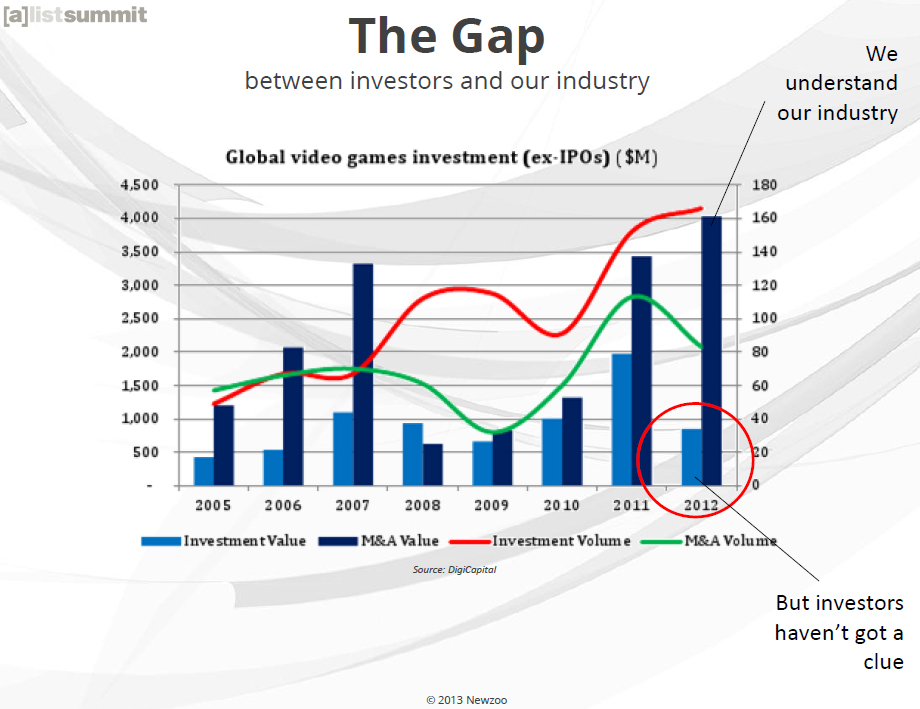By Meelad Sadat
Investments in games from outside the game industry dropped by half last year compared to 2011, according to Newzoo. Peter Warman, who heads the firm, believes it’s because investors are lost in hyped up terminology as the industry struggles to define changes. He also blames press headlines about company failures and category declines that can be misinterpreted as broad consumer flight from games.
Speaking at Ayzenberg’s [a]list summit New York, Warman said chasing away investors is one of three reasons it’s time step back and look at the game industry differently. The other two — where the industry is headed with the growth in digital and mobile games, and how companies need to approach the market differently because of gamers’ divided attention.
“We’re scaring away investors a little bit because we use a lot of jargon, and our market is changing so fast,” said Warman.
Newzoo data shows a robust and growing global market for games, but it is shifting. Games brought in $68 billion in revenue in 2012, which Newzoo estimates came from nearly 900 million game consumers worldwide. Console and PC games still make up the bulk of revenues yet market growth is being driven by multiple screens. On mobile alone, Newzoo estimates the category attributed $9 billion to game sales last year and will grow by 32 percent this year. Even as packaged game sales decline, the growth in the mobile category is helping overall growth for the industry. Newzoo forecasts seven percent year-over-year growth for the industry as a whole.
It spells opportunity. Warman sees difficulty in taking advantage of it without profound realizations within and outside the game industry that the way people spend money on games has changed.
Newzoo estimates that 37 percent of paying gamers in the U.S. are spending their money across different platforms, divided between console, PC, mobile and tablet games. Warman calls UK “even more multi-screen crazy,’ with 40 percent there spreading their money and attention to at least one other screen, and where more than a quarter of all gamers are playing on all screens. These two major markets point to a continuing shift worldwide.
“Even if you have a paying gamer, you’re only getting a portion of his wallet,” he said.
Warman guessed that a single screen game is chasing less than a third of a game buyer’s budget. While that should affect product strategy for games that can live on multiple platforms, the bigger test might be for marketers.
“Everyone involved in marketing of games and monetizing games is now facing the challenge – to get the same share of wallet of a consumer, they need to follow a consumer across screens,” said Warman.
“The good news is game companies have terrific content,”he added. “What’s better to engage consumers across screens than content, because content travels across all screens.”
Turning back to investments, Warman put part of the blame for last year’s decline in investor capital from outside the industry on how press covers the games business. He pointed to recent attention grabbing headlines about category declines in social games and game retail sales. The industry is good at making for great news reading with fantastic fits and failures, recently with Zynga, 38 Studios and THQ for instance. For an outsider, it can be easy to overlook how these are fallouts from an industry in flux, one that’s always been cyclical, and ignore that it’s still growing in spite of it.
Warman said that seeing outside investments in games cut in half between 2011 and 2012 is worrying, but at the same time those familiar with the industry are reading through the lines.
“Mergers and acquisitions are still on the rise, so we still understand our industry, we know where to invest in, who to acquire,” said Warman. “But from an [outsider] investment standpoint, Zynga, Facebook stocks go down, and they run away, and they’re scared of anything related to gaming. And now you can see that in hard figures, and now is the time to work together to do something about it, I think. Otherwise we’re in trouble.”


















